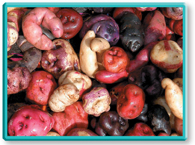Valuing Biodiversity You can't touch, smell, or eat biodiversity, so many people don't think of it as a natural resource. But biodiversity is one of Earth's greatest natural resources.  Biodiversity's benefits to society include contributions to medicine and agriculture, and the provision of ecosystem goods and services. When biodiversity is lost, significant value to the biosphere and to humanity may be lost along with it.
Biodiversity's benefits to society include contributions to medicine and agriculture, and the provision of ecosystem goods and services. When biodiversity is lost, significant value to the biosphere and to humanity may be lost along with it.
▸ Biodiversity and Medicine Wild species are the original source of many medicines, including painkillers like aspirin and antibiotics like penicillin. The chemicals in wild species are used to treat diseases like depression and cancer. For example, the foxglove, shown in Figure 6–14, contains compounds called digitalins that are used to treat heart disease. These plant compounds are assembled according to instructions coded in genes. So the genetic information carried by diverse species is like a “natural library” from which we have a great deal to learn.
▸ Biodiversity and Agriculture Genetic diversity is also important in agriculture. Most crop plants have wild relatives, like the potatoes in Figure 6–15. These wild plants may carry genes we can use—through plant breeding or genetic engineering—to transfer disease or pest resistance, or other useful traits, to crop plants.
▸ Biodiversity and Ecosystem Services The number and variety of species in an ecosystem can influence that ecosystem's stability, productivity, and value to humans. Sometimes the presence or absence of a single keystone species, like the sea otter in Figure 6–16, can completely change the nature of life in an ecosystem. Also, healthy and diverse ecosystems play a vital role in maintaining soil, water, and air quality.

FIGURE 6–14 Medicinal Plants Digoxin, a drug derived from digitalin compounds in the foxglove plant, is used to treat heart disease.

FIGURE 6–15 Potato Diversity The genetic diversity of wild potatoes in South America can be seen in the colorful varieties shown here. The International Potato Center, based in Peru, houses a “library” of more than 4500 tuber varieties.

FIGURE 6–16 Keystone Species The sea otter is a keystone species. When the otter population falls, the population of its favorite prey, sea urchins, goes up. Population increases in sea urchins, in turn, cause a dramatic decrease in the population of sea kelp, the sea urchin's favorite food.

Table of Contents
- Formulas and Equations
- Applying Formulas and Equations
- Mean, Median, and Mode
- Estimation
- Using Measurements in Calculations
- Effects of Measurement Errors
- Accuracy
- Precision
- Comparing Accuracy and Precision
- Significant Figures
- Calculating With Significant Figures
- Scientific Notation
- Calculating With Scientific Notation
- Dimensional Analysis
- Applying Dimensional Analysis




